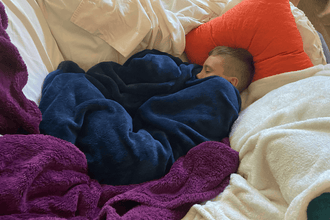
What Is a Sensory Toy? Benefits, Types, and How to Choose the Best One
TABLE OF CONTENTS
What are sensory toys and how do they aid development is a question that many parents and caregivers ask. Through play, sensory toys stimulate the senses and aid in the development of children's motor abilities, emotional control, and focus. I discuss the primary categories of sensory toys in this post, along with their advantages and tips for choosing the best ones to meet your child's developmental needs.
What Are Sensory Toys?
Definition and Purpose
Sensory toys are items created to stimulate one of the five senses—sight, touch, smell, taste, or sound. These tools encourage children to explore, experiment, and interact with their surroundings. Daily play with these tools supports cognitive growth, coordination, emotional regulation, and early learning skills.
Common Categories of Sensory Toys
The types of sensory play equipment are varied. Tactile tools, like fidget spinners and textured balls stimulate the sense of touch. Toys that use light or vision, such as fiber-optic lights or bubble tubes, engage visual perception. Auditory tools including musical instruments or sound blocks help develop listening and rhythm. Movement or pressure-based equipment, such as weighted blankets, balance toys, helps with proprioception and motor skills. All of these tools can be used at home, in therapy sessions, or in classrooms.
How Sensory Play Supports Learning and Growth?
Engaging in sensory play promotes problem-solving, hands-on exploration, and attention development. These tools enhance coordination, fine and gross motor skills, and focus during structured or free play. Especially children with sensory processing difficulties like autism, or ADHD often find them reducing stress and supporting emotional regulation. Structured activities with sensory toys also foster creativity, confidence, and social interaction in group settings.
Who Can Benefit from Sensory Play Tools?
Sensory play tools benefit children at every developmental stage, not only those with special needs. They help toddlers develop motor skills and basic sensory awareness while helping preschoolers strengthen focus and self-control. Children with ADHD, autism, or anxiety often gain additional advantages from structured sensory activities. For them, a sensory-rich environment helps improve emotional management, attention, and social engagement.
How to Choose the Right Sensory Toys for Your Child?
Observe Your Child’s Sensory Preferences
Every child responds to sensory inputs differently. It's always crucial to figure out your child's sensory preferences on textures, sounds, and movements. Some kids might prefer bright colors and active play, while others might enjoy calm, deep-pressure input. Only after understanding these likes and dislikes, can you choose the corresponding play items that truly meet their needs.
Match Toys to Age and Skill Level
Select toys that match your child’s developmental stage. Young children benefit from simple, safe items like soft balls or textured mats. Older children may enjoy more challenging items, like balance boards or puzzles. Choosing things that are appropriate for the child's age keeps them interested and reduces frustration.
Prioritize Safety and Quality
Safety and quality of materials always come first. Avoid small parts for toddlers for choking hazard. Choose non-toxic materials. Look for toys certified by ASTM or CPSIA standards. High-quality sensory toys provide stimulation without overwhelming the child.
Incorporating Sensory Play into Daily Life
Other than scheduled sessions, their advantages are increased when sensory play tools are used throughout the day. For example, morning movement breaks with a balance board, quiet time in a peapod chair, or tactile play with fidget items after school can help children regulate emotions and maintain focus. Self-regulation, motor skills, and attention are all supported by the regular, purposeful use of developmental play items. Establishing a sensory-rich environment at home encourages kids to explore, be creative, and stick to healthy routines.
Recommended Sensory Play Tools
Sensory Swing
Sensory swings move in a way that is calming and helps kids control their emotions and improve their balance. For instance, the Outree sensory swing sends gentle vestibular input to help with focus and coordination.

Visual and Light-Based Toys
Toys that use light and color stimulate the senses and encourage exploration. Bubble tubes, fiber-optic lamps, and projection lights can help kids calm down and pay more attention.

Balance Equipment
Balance toys help develop core strength, spatial awareness, and gross motor skills. Children can improve their coordination and confidence by using stepping stones and balancing boards.

Fidget and Manipulative Toys
Through repetitive motion, fidget and manipulative toys lower stress and enhance focus. Tactile stimulation from objects like stress balls, textured rings, and spinners promotes focused calmness.
Sensory Body Wear
Proprioceptive input and calming pressure are provided by sensory body wear. Weighted vests help kids feel focused and grounded, while body socks improve body awareness during active play.

Musical and Auditory Toys
Talking toys, sound blocks, and musical instruments all arouse the sense of hearing. These toys offer calming or stimulating auditory feedback while improving memory, rhythm, and listening skills.
Water and Messy Play Items
Slime kits, sand toys, and water tables offer tactile sensory experiences. They promote hand-eye coordination, creativity, and tactile exploration in an enjoyable, engaging manner.
Conclusion
Sensory toys play a critical role in children’s physical, cognitive, and emotional development. Meaningful and secure sensory experiences are ensured by paying attention to preferences, selecting age-appropriate equipment, and emphasizing quality. Whether using swings, balance equipment, body wear, or manipulative tools, these activities help children explore their senses, build confidence, and develop essential skills. Incorporating a variety of sensory play items into daily routines promotes learning, self-regulation, and healthy development.
Ready to enhance your child’s sensory experiences at home? Explore Outree’s range of high-quality sensory play equipment and find the perfect tools to support your child’s growth, concentration, and confidence.









